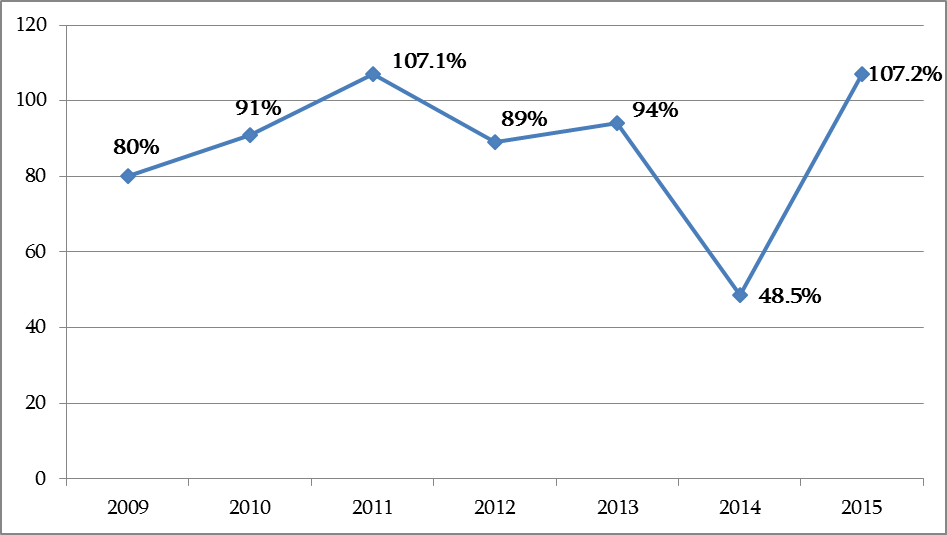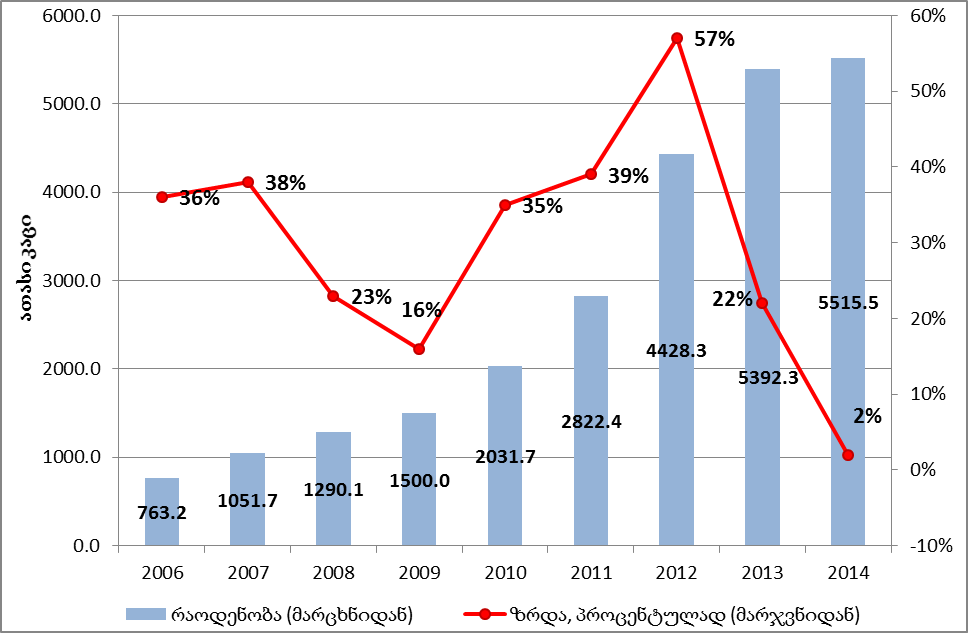In terms of FactCheck’s Check Your Fact service, our reader, Mikheil Sukhiashvili, asked us to verify the accuracy of a statement made by the Minister of Finance of Georgia, Nodar Khaduri. According to the Minister, the standard of living in Georgia has not changed for the past nine years and the country still holds the 114th place in the world.
FactCheck verified the accuracy of this statement.
Standard of living reflects the provision of the population with various types of material and non-material wealth. The easiest way for assessing the standard of living is the Gross Domestic Product (GDP) per capita. It shows the average value of goods and services for one person for one year. However, the standard of living cannot be adequately assessed by the GDP per capita alone. The level of unemployment in the country, the availability and quality of education, average life expectancy and the distribution of income are also very important for the assessment of the standard of living.
The growth of productivity and the GDP greatly affect the increase of the standard of living. Georgia’s GDP has grown very quickly since 2003 as has the GDP per capita. According to the data of the International Monetary Fund (IMF), Georgia’s GDP per capita amounted to USD 3,607 in 2014 which, indeed, puts it in the 114th place in the world. Georgia held the 128th place with USD 686 in 2000. It was in the 128th place with USD 919 in 2003 and in the 116th place in 2012 with USD 3,523.
The position of any country in these ratings is relative and depends upon the economic growth in other countries as well. Economic growth was quite high from 2004 to 2008 for the world overall (an average of 5%) and in developing countries (7%-8%).
Graph 1: Economic Growth of the World, Developing Countries and Georgia from 2004 to 2014
 Source: International Monetary Fund
It should be noted that real indicators give more important information rather than nominal indicators. In this sense, it is very important to calculate the GDP by Purchasing Power Parity (PPP). Taking into account the Purchasing Power Parity in USD, these data reflect the value of the consumer basket which Georgian citizens can afford with their average nominal income. For example, if the nominal income per capita is USD 3,200 whilst by Purchasing Power Parity it amounts to USD 7,200, this means that the value of the production which we can buy for USD 3,200 in Georgia would be USD 7,200 in the United States of America.
According to the data of the International Monetary Fund, the GDP per capita by Purchasing Power Parity in Georgia equalled USD 2,581 (125th place) in 2000, USD 3,428 (122nd) in 2003, USD 6,812 (117th) in 2012 and USD 7,666 (114th) in 2014. As we can see, both the GDP and the GDP per capita have grown since 2000 which has affected the standard of living as well.
Graph 2: Georgia’s GDP Per Capita (Nominal and by Purchasing Power Parity) from 2000 to 2014
Source: International Monetary Fund
It should be noted that real indicators give more important information rather than nominal indicators. In this sense, it is very important to calculate the GDP by Purchasing Power Parity (PPP). Taking into account the Purchasing Power Parity in USD, these data reflect the value of the consumer basket which Georgian citizens can afford with their average nominal income. For example, if the nominal income per capita is USD 3,200 whilst by Purchasing Power Parity it amounts to USD 7,200, this means that the value of the production which we can buy for USD 3,200 in Georgia would be USD 7,200 in the United States of America.
According to the data of the International Monetary Fund, the GDP per capita by Purchasing Power Parity in Georgia equalled USD 2,581 (125th place) in 2000, USD 3,428 (122nd) in 2003, USD 6,812 (117th) in 2012 and USD 7,666 (114th) in 2014. As we can see, both the GDP and the GDP per capita have grown since 2000 which has affected the standard of living as well.
Graph 2: Georgia’s GDP Per Capita (Nominal and by Purchasing Power Parity) from 2000 to 2014
 Source: International Monetary Fund
When assessing the standard of living, apart from the growth of the GDP, it is also important to keep track of how equally the income is distributed among the population. This is calculated by the Gini Index. The lower the Gini Index, the more equally the wealth is distributed and vice versa. The Gini Index was 40.5 in Georgia in 2000. It decreased to 39.8 in 2004. However, it grew again in the following years and amounted to 42.1 in 2010. It decreased once again to 41.4 in 2012. As we can see, the income inequality has grown in the past years; however, this indicator decreased slightly from 2010 to 2012.
Indices calculated by various international organisations, including all of the factors mentioned above, can also be used for measuring the standard of living. The United Nations Human Development Index (HDI) is one of the most popular tools for measuring the standard of living as it includes not only income per capita but the quality of education and healthcare as well (it does not, however, take income inequality and poverty into account). According to the 2014 data, Georgia’s HDI amounted to 0.744 which puts it in the 79th position in the world. It should be pointed out that Georgia’s HDI grew from 0.71 to 0.744 from 2005 to 2013.
Table 1: Statistical Data for Assessing Standard of Living
Source: International Monetary Fund
When assessing the standard of living, apart from the growth of the GDP, it is also important to keep track of how equally the income is distributed among the population. This is calculated by the Gini Index. The lower the Gini Index, the more equally the wealth is distributed and vice versa. The Gini Index was 40.5 in Georgia in 2000. It decreased to 39.8 in 2004. However, it grew again in the following years and amounted to 42.1 in 2010. It decreased once again to 41.4 in 2012. As we can see, the income inequality has grown in the past years; however, this indicator decreased slightly from 2010 to 2012.
Indices calculated by various international organisations, including all of the factors mentioned above, can also be used for measuring the standard of living. The United Nations Human Development Index (HDI) is one of the most popular tools for measuring the standard of living as it includes not only income per capita but the quality of education and healthcare as well (it does not, however, take income inequality and poverty into account). According to the 2014 data, Georgia’s HDI amounted to 0.744 which puts it in the 79th position in the world. It should be pointed out that Georgia’s HDI grew from 0.71 to 0.744 from 2005 to 2013.
Table 1: Statistical Data for Assessing Standard of Living
Sources: National Statistics Office of Georgia, World Bank, International Monetary Fund
Conclusion
Standard of living is based upon the provision of the population with material and non-material wealth. Economic growth has a significant influence upon improving the standard of living. The Georgian economy was increasing from 2000 to 2012 with the GDP per capita also growing accordingly, from USD 919 to USD 3,523 from 2003 to 2012. Georgia moved from the 128th to the 116th place in the world by the GDP per capita.
Economic growth influenced the standard of living as well as is illustrated by the changes in Georgia’s positions in international ratings. As of today, Georgia holds the 114th position in the world by the GDP per capita (USD 3,607). It should also be noted that a country’s position in these ratings is relative and it depends upon the economic growth in other countries as well. Hence, if the position of a country with regard to other countries does not improve, it does not necessarily mean that the standard of living in the country is not being improved. The United Nations Human Development Index for Georgia indicates an improvement in the standard of living, changing from 0.71 to 0.744 from 2005 to 2013.
However, it should also be noted that despite the economic growth, unemployment and poverty still remain among the most serious challenges for Georgia.
FactCheck concludes that Nodar Khaduri’s statement is MOSTLY FALSE.
 Source: International Monetary Fund
It should be noted that real indicators give more important information rather than nominal indicators. In this sense, it is very important to calculate the GDP by Purchasing Power Parity (PPP). Taking into account the Purchasing Power Parity in USD, these data reflect the value of the consumer basket which Georgian citizens can afford with their average nominal income. For example, if the nominal income per capita is USD 3,200 whilst by Purchasing Power Parity it amounts to USD 7,200, this means that the value of the production which we can buy for USD 3,200 in Georgia would be USD 7,200 in the United States of America.
According to the data of the International Monetary Fund, the GDP per capita by Purchasing Power Parity in Georgia equalled USD 2,581 (125th place) in 2000, USD 3,428 (122nd) in 2003, USD 6,812 (117th) in 2012 and USD 7,666 (114th) in 2014. As we can see, both the GDP and the GDP per capita have grown since 2000 which has affected the standard of living as well.
Graph 2: Georgia’s GDP Per Capita (Nominal and by Purchasing Power Parity) from 2000 to 2014
Source: International Monetary Fund
It should be noted that real indicators give more important information rather than nominal indicators. In this sense, it is very important to calculate the GDP by Purchasing Power Parity (PPP). Taking into account the Purchasing Power Parity in USD, these data reflect the value of the consumer basket which Georgian citizens can afford with their average nominal income. For example, if the nominal income per capita is USD 3,200 whilst by Purchasing Power Parity it amounts to USD 7,200, this means that the value of the production which we can buy for USD 3,200 in Georgia would be USD 7,200 in the United States of America.
According to the data of the International Monetary Fund, the GDP per capita by Purchasing Power Parity in Georgia equalled USD 2,581 (125th place) in 2000, USD 3,428 (122nd) in 2003, USD 6,812 (117th) in 2012 and USD 7,666 (114th) in 2014. As we can see, both the GDP and the GDP per capita have grown since 2000 which has affected the standard of living as well.
Graph 2: Georgia’s GDP Per Capita (Nominal and by Purchasing Power Parity) from 2000 to 2014
 Source: International Monetary Fund
When assessing the standard of living, apart from the growth of the GDP, it is also important to keep track of how equally the income is distributed among the population. This is calculated by the Gini Index. The lower the Gini Index, the more equally the wealth is distributed and vice versa. The Gini Index was 40.5 in Georgia in 2000. It decreased to 39.8 in 2004. However, it grew again in the following years and amounted to 42.1 in 2010. It decreased once again to 41.4 in 2012. As we can see, the income inequality has grown in the past years; however, this indicator decreased slightly from 2010 to 2012.
Indices calculated by various international organisations, including all of the factors mentioned above, can also be used for measuring the standard of living. The United Nations Human Development Index (HDI) is one of the most popular tools for measuring the standard of living as it includes not only income per capita but the quality of education and healthcare as well (it does not, however, take income inequality and poverty into account). According to the 2014 data, Georgia’s HDI amounted to 0.744 which puts it in the 79th position in the world. It should be pointed out that Georgia’s HDI grew from 0.71 to 0.744 from 2005 to 2013.
Table 1: Statistical Data for Assessing Standard of Living
Source: International Monetary Fund
When assessing the standard of living, apart from the growth of the GDP, it is also important to keep track of how equally the income is distributed among the population. This is calculated by the Gini Index. The lower the Gini Index, the more equally the wealth is distributed and vice versa. The Gini Index was 40.5 in Georgia in 2000. It decreased to 39.8 in 2004. However, it grew again in the following years and amounted to 42.1 in 2010. It decreased once again to 41.4 in 2012. As we can see, the income inequality has grown in the past years; however, this indicator decreased slightly from 2010 to 2012.
Indices calculated by various international organisations, including all of the factors mentioned above, can also be used for measuring the standard of living. The United Nations Human Development Index (HDI) is one of the most popular tools for measuring the standard of living as it includes not only income per capita but the quality of education and healthcare as well (it does not, however, take income inequality and poverty into account). According to the 2014 data, Georgia’s HDI amounted to 0.744 which puts it in the 79th position in the world. It should be pointed out that Georgia’s HDI grew from 0.71 to 0.744 from 2005 to 2013.
Table 1: Statistical Data for Assessing Standard of Living
| 2000 | 2003 | 2012 | 2014 | |
| GDP Per Capita (USD) | 686 | 919 | 3,523 | 3,607 |
| Georgia’s Rating by GDP Per Capita | 128 | 128 | 116 | 114 |
| GDP Per Capita by Purchasing Power Parity (USD) | 2,581 | 3,429 | 6,812 | 7,666 |
| Georgia’s Rating by GDP Per Capita by Purchasing Power Parity | 125 | 122 | 117 | 114 |
| HDI (Human Development Index) | 0.71 | 0.741 | 0.744 | |
| Gini Index | 40.5 | 39.5 | 41.4 |
Tags:








